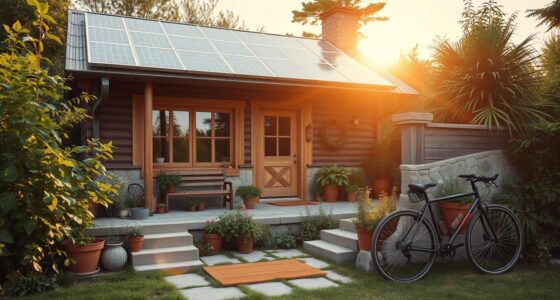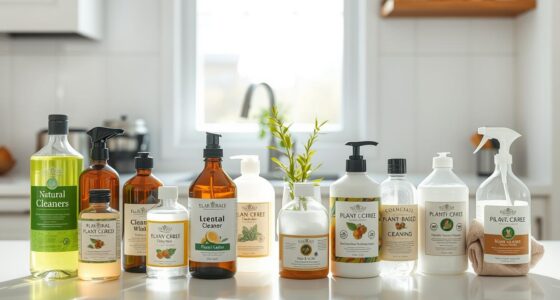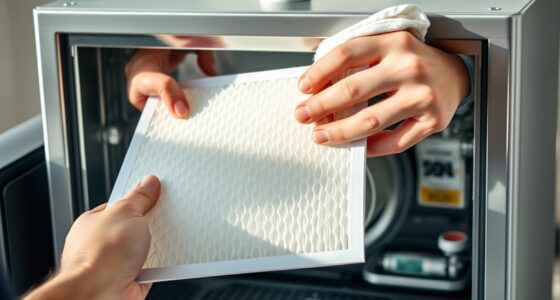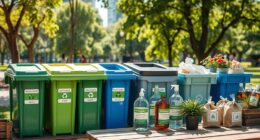To build a green cleaning kit on a budget, start with common ingredients like vinegar, baking soda, lemon juice, and Castile soap, which are versatile and affordable. Reuse jars and spray bottles for storage, labeling them clearly to stay organized. Buy in bulk and shop sales to save money, and keep everything within easy reach to make cleaning simple and eco-friendly. Keep exploring to discover more tips for creating an effective, sustainable cleaning kit that saves you money.
Key Takeaways
- Use common pantry ingredients like vinegar, baking soda, and lemon juice for versatile, affordable cleaning solutions.
- Repurpose jars and containers with clear labels for eco-friendly, cost-effective storage.
- Buy in bulk and wait for sales to reduce costs and minimize packaging waste.
- Incorporate eco-friendly tools like airless paint sprayers to enhance DIY projects sustainably.
- Keep supplies organized in one accessible spot to streamline cleaning and encourage consistent green practices.
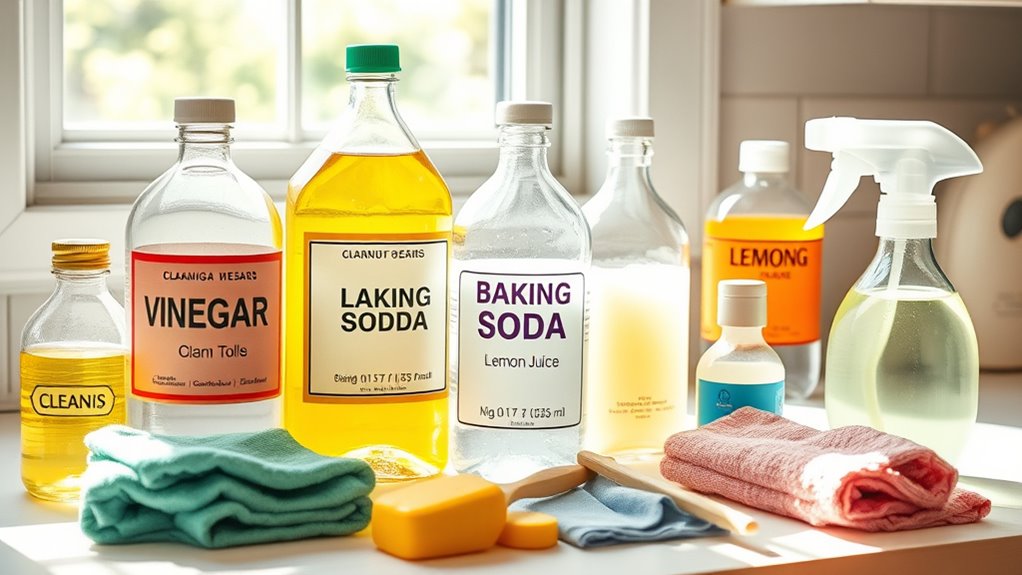
Creating a green cleaning kit doesn’t have to break the bank. In fact, you can assemble an effective, eco-friendly setup without spending a fortune. The key is to focus on simple, natural ingredients that are both affordable and safe for your home and the environment. Eco friendly ingredients like white vinegar, baking soda, lemon juice, and castile soap are versatile and cost-effective. These items can tackle a wide range of cleaning tasks, from degreasing kitchen counters to freshening up bathroom fixtures. You probably already have some of these staples in your pantry, so you won’t need to buy much to start your green cleaning journey.
To keep your supplies organized and accessible, budget storage solutions are essential. You don’t need fancy containers; repurposed jars, spray bottles, and old plastic containers work just fine. Label each container clearly to avoid confusion, and keep everything in one spot to streamline your cleaning routine. Using transparent containers allows you to see at a glance when supplies are running low, helping you stay on top of replenishing your eco-friendly ingredients. You can even decorate or personalize your storage solutions to make the space inviting and motivating.
When selecting your eco-friendly ingredients, look for multi-purpose products that reduce clutter and save money. For example, white vinegar mixed with water makes an excellent all-purpose cleaner, while baking soda can be used for scrubbing sinks, tubs, and even carpets. Lemon juice not only adds a fresh scent but also works as a natural disinfectant. Castile soap is another versatile ingredient that can be used for everything from washing surfaces to creating gentle hand soaps. By sticking to these basics, you avoid purchasing a bevy of specialized cleaners that often contain harsh chemicals and unnecessary packaging.
Additionally, investing in an eco-friendly airless paint sprayer for home improvement projects can contribute to a greener lifestyle by reducing waste and improving efficiency in your DIY tasks. As you build your kit, consider buying in bulk when possible. Bulk stores or online shops often offer better prices for eco-friendly ingredients, which helps you save money over time. Keep an eye out for sales or discounts on reusable spray bottles and storage containers, which can double your savings. The goal is to create a simple, effective kit that’s sustainable both environmentally and financially. By using eco friendly ingredients and budget storage solutions, you’ll not only save money but also reduce your carbon footprint and create a healthier home environment.
Ultimately, building a green cleaning kit on a budget is about making smart choices and using what you already have. With a little planning and some basic ingredients, you can maintain a clean space without compromising your values or your wallet.
Frequently Asked Questions
Are Homemade Green Cleaning Solutions as Effective as Store-Bought Ones?
Homemade green cleaning solutions can be just as effective as store-bought ones if you prioritize DIY safety and choose the right ingredients. Vinegar, baking soda, and lemon are powerful and safe cleaners when used properly. You just need to understand ingredient effectiveness and avoid unsafe DIY practices. With proper research and caution, your homemade solutions will clean effectively while keeping your home safe and eco-friendly.
How Long Do Homemade Green Cleaners Typically Last?
Coincidentally, homemade green cleaners often last about one to three months, depending on ingredients. You should check their shelf life regularly, especially if they contain natural preservatives. Store them in airtight containers away from sunlight and heat to extend their effectiveness. Proper storage tips, like labeling bottles and shaking before use, help maintain their potency. Usually, if they develop an off smell or change color, it’s time to make a fresh batch.
Can Eco-Friendly Cleaning Products Be Used on All Surfaces?
Yes, eco-friendly cleaning products can be used on most surfaces, but you should always check surface compatibility and ingredient safety first. Some natural ingredients work well on counters, glass, and wood, but others may damage delicate materials like marble or certain plastics. Always read labels carefully, test a small area first, and choose products designed for specific surfaces to guarantee safe, effective cleaning without harm.
Are There Any Safety Concerns With DIY Green Cleaning Ingredients?
Like a double-edged sword, DIY green cleaning ingredients can pose safety concerns. You might trigger chemical reactions or ingredient allergies if you’re not careful. Always test solutions on small areas first and store them safely out of reach of children and pets. Keep in mind, natural doesn’t always mean safe—be aware of potential irritants, and research ingredients thoroughly to avoid unintended health issues.
What Are the Best Budget-Friendly Sources for Eco-Friendly Cleaning Supplies?
You can find eco-friendly cleaning supplies at discount stores and through bulk buying options. Discount stores often carry affordable, natural cleaning products, while bulk buying helps you save money and reduce packaging waste. Look for store brands or natural ingredient-based items, and consider shopping online for deals on sustainable supplies. These sources make it easy to build an eco-friendly cleaning kit without overspending.
Conclusion
Creating a green cleaning kit doesn’t have to break the bank. By choosing simple, natural ingredients, you’re not only saving money but also protecting your family and the environment. Some swear by vinegar’s cleaning power—it’s been used for centuries, proving natural solutions can be just as effective as store-bought chemicals. So, trust the science and your instincts—your wallet and the planet will thank you for making eco-friendly choices every time you clean.


